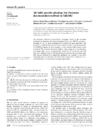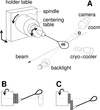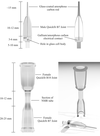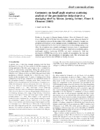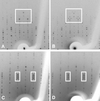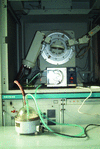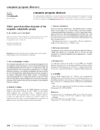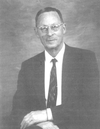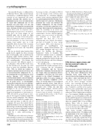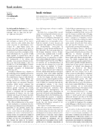issue contents
April 2004 issue

Cover illustration: Volumetric visualization of electron density surrounding a histidine residue, allowing for direct observation of discrete disorder; generated with POVScript+ and rendered with POVRay. Courtesy of T. D. Fenn, D. Ringe & G. A. Petsko [J. Appl. Cryst. (2003), 36, 944-947].
research papers
Diffuse scattering data from natural mordenite crystals are shown to exhibit a complex distribution of weak features which have been mapped out using a synchrotron X-ray source and a CCD detector. Comparison with computer-simulated diffuse scattering patterns yields a detailed three-dimensional columnar defect structure and reveals that roughly one third of the mordenite's columnar defects cooperate to form a block-mosaic pattern of {110} stacking faults.
The polarization state of BaTiO3 thin films was switched by employing external electric fields. Using the anomalous signal of the Ba atom, the structural differences between the two polarization states were determined from X-ray diffraction experiments.
X-ray topographic images of inclusions in SiC are described, and compared with similar images of micropipes and with computer simulations. The natures of both types of defect image are discussed.
Error-correcting codes are used to increase the efficiency of powder pattern decomposition techniques in phasing procedures.
The performance of SANS instruments using a combination of variable-geometry converging multichannel collimator units is discussed. Guidelines for the implementation of XY variable-geometry converging multichannel collimation are given.
Angle calculations are presented for a new `hybrid' diffractometer that consists of a base instrument that can be combined with two different detector arms. The inclusion of a second sample rotation stage is discussed.
Analytical expressions for the scattering form factor and radius of gyration for a cylinder with globular end-caps are presented. The possible applications of the form factor in colloidal and biological systems are discussed.
Open  access
access
 access
accessStatistical tests based on Pearson and Spearman coefficients and the Kolmogorov–Smirnov test are used to match powder diffraction patterns qualitatively using the full peak profiles. The method can be extended to quantitative analysis using least squares via singular value decomposition.
Open  access
access
 access
accessA correlation matrix is generated to compare full profile powder patterns. This is followed by cluster analysis, multivariate data analysis and data visualization to classify the patterns into groups and thus to identify polymorphs and mixtures.
Methods for collecting and processing wavelength-resolved Laue data at the protein crystallography station at Los Alamos Neutron Science Center have been developed.
The Patterson deconvolution method has been implemented in the SIR2002 program, allowing the ab initio solution of protein crystal structures in a very short computing time.
A fully automated image analysis method for detecting and centring protein crystals for X-ray crystallography is described.
This work concerns dislocation microstructure analysis in order to assess stored elastic energy using Fourier coefficients of diffraction lines. These coefficients are related to the lattice distortion heterogeneity evaluated using a micromechanical approach.
A curve-tracking computer algorithm to classify crystallization images automatically is described.
Download citation


Download citation


The crystal structure of diclofenac embedded in a diclofenac-containing chitosan matrix has been determined from conventional X-ray powder diffraction data.
A time-resolved SAXS study on the crystalline morphology of long-term stored isotactic polypropylene
The crystalline morphology of a long-term stored metallocene isotactic polypropylene (mPP) is compared with that of a freshly crystallized sample. It is found that both α and γ crystal forms occur in the long-term stored mPP, whereas freshly crystallized mPP contains only the α crystal form; it is inferred that the crystal stacks of the α and γ forms in the long-term stored mPP are arranged according to the block mode.
Crystallite sizes and microstrains in ball-milled molybdenum, as determined from diffraction-line broadening analysis, depend on the method of analysis. Broadening due to microstrain can be simulated with a strain field model.
Download citation


Download citation


Open  access
access
 access
accessA new cell for studying electrocrystallization in situ on a diffractometer is reported, in which the working electrode, fabricated from a propelling pencil lead encased in glass, is designed to sit in the path of the incident X-ray beam so that processes occurring at its tip can be studied using diffraction methods. Practical difficulties of both design and data collection are discussed, as well as advantages and limitations of the method.
cryocrystallography papers
A helium-purged beam path implemented at the Elettra X-ray diffraction beamline is described. The advantages of its use are analysed for diffraction data collected at wavelengths in the range 1.5–2.65 Å.
short communications
Open  access
access
 access
accessComment on Staron, Jamnig, Leitner, Ebner & Clemens [J. Appl. Cryst. (2003>), 36, 415–419].
The rotation method and fine φ-slicing have been used to visualize the modulated diffraction pattern of a semi-crystalline state of profilin:actin.
computer programs
Open  access
access
 access
accessA new search algorithm, 3DSEARCH, is presented that can identify challenging extended chemical queries from three-dimensional crystal structure data. Timing information is presented for example searches, which demonstrate the ability of the algorithm to identify queries containing several substructures and several intermolecular connections.
CIF applications
Free 

enCIFer is an interactive program which permits files in CIF format to be viewed, and syntax errors to be located and corrected for both individual and looped data items. The software also allows new data to be incorporated and the structure(s) contained in a small-molecule CIF to be visualized and manipulated.
laboratory notes
Hot pressing of germanium (311) single crystal at 1073 K at a pressure of 10.7 MPa gives typical mosaic widths of 0.5° in one direction and 0.2° in the other.
Open  access
access
 access
accessThe development of a novel device for examining the three-dimensional structure of shear-aligned soft materials using small-angle X-ray scattering is reported.
A new fast chemical method for cleaning X-ray tubes from deposited carbonates, based on the high affinity of citric acid toward calcium and magnesium, is presented.
computer program abstracts
Three-dimensional general position diagrams of all magnetic subperiodic groups have been developed. Each diagram can be rotated and zoomed to aid in the visualization of the general position diagram and includes both the general positions of the atoms and the general orientations of the associated magnetic moments.
A Tcl/Tk graphical user interface has been developed for the X-ray diffraction data processing package XDS. The interface simplifies routine tasks, such as input file retrieval and editing, examination of the output and file format conversion.
crystallographers
Free 

Free 

Free 

book reviews
Open  access
access
 access
access

 journal menu
journal menu


















